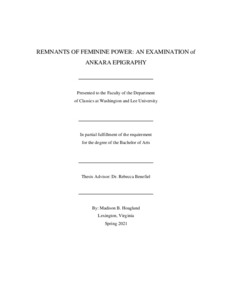Remnants of Feminine Power: An Examination of Ankara Epigraphy (thesis)

View/
Author
Hoaglund, Madison B.
Subject
Washington and Lee University -- Honors in Classics
Women epigraphists
Inscriptions
Turkey -- Ankara
Metadata
Show full item recordDescription
Thesis; [FULL-TEXT FREELY AVAILABLE ONLINE] Madison B. Hoaglund is a member of the Class of 2021 of Washington and Lee University. The ancient city of Ancyra provides a wealth of inscriptions over six hundred years. Throughout this period, women actively participated in the epigraphic habit. For this project, I compiled both volumes of David French and Stephen Mitchell's The Greek and Latin inscriptions of Ankara (Ancyra) to assess the overall trends of women in inscriptions. The central question of the project is, did the role of women in Ankara's inscriptions change? Dividing my corpus into three separate periods: Roman, Transitional, and Late Antique, I examined five hundred and forty-five inscriptions. Women appear in the funerary and honorific epigraphic categories throughout the entire corpus. After much analysis, it is clear that Ancyra's epigraphy evolved significantly over the three periods for a variety of complex social, political, and religious factors like the introduction of Christianity or loosening of Roman control. The inscriptions of Ankara women transformed alongside the stylistic changes of the three different periods. In each period, influential, educated, and wealthy women emerge as epigraphically significant examples and prominent members of society. Epigraphy is a way to tangibly access antiquity and give a voice to the marginalized groups in the society. Ankara women have a definite presence in epigraphy that remains consistent
throughout the three periods.